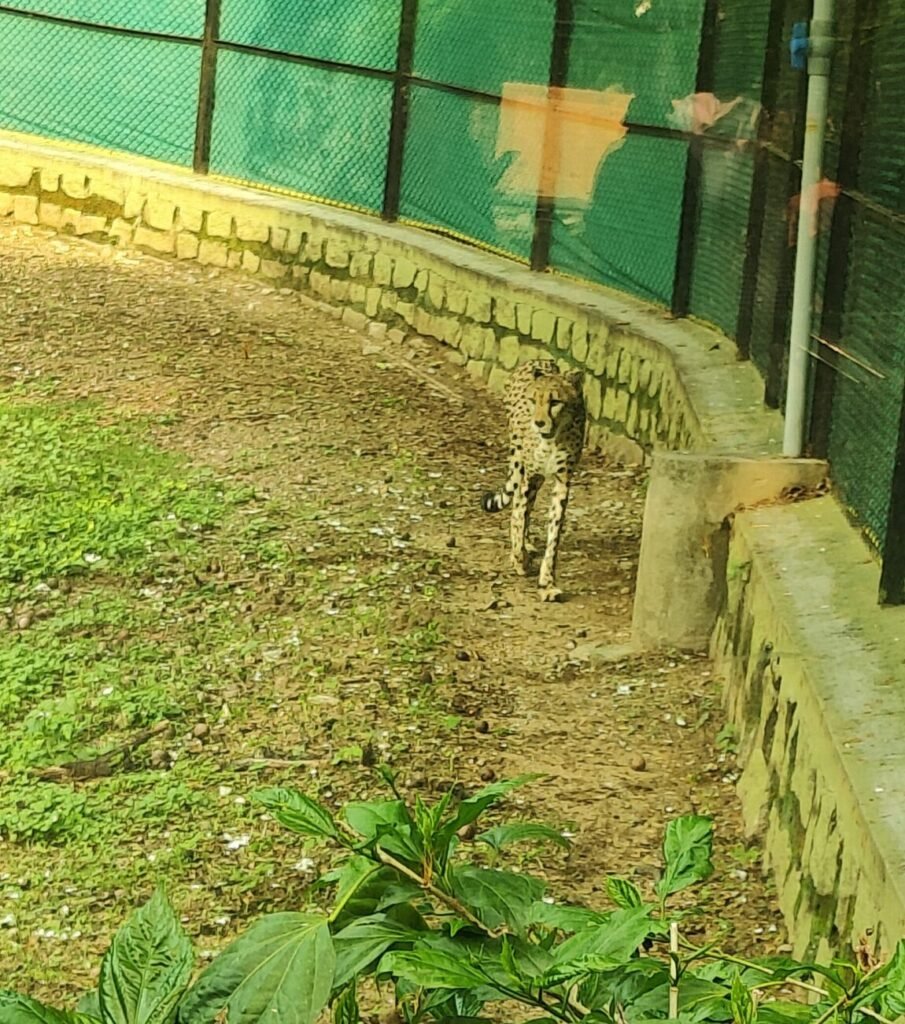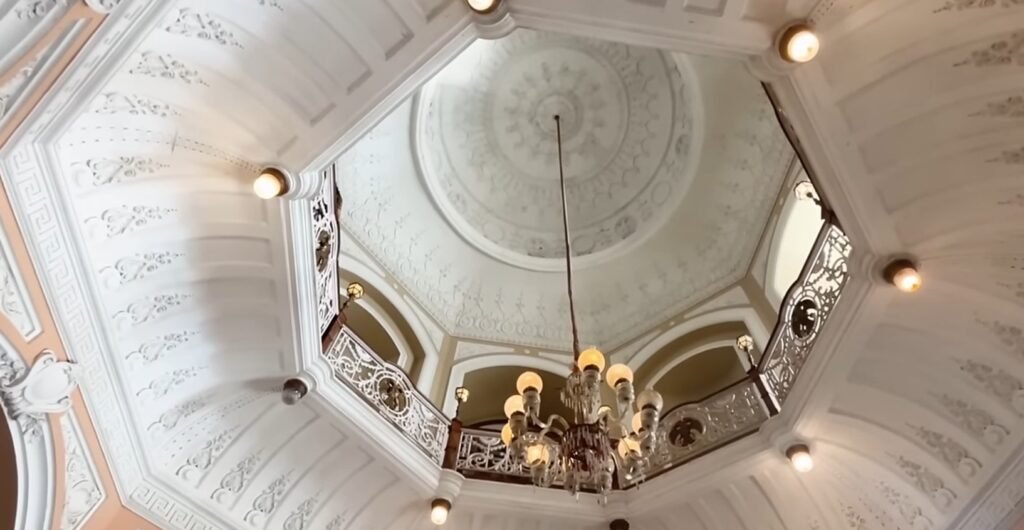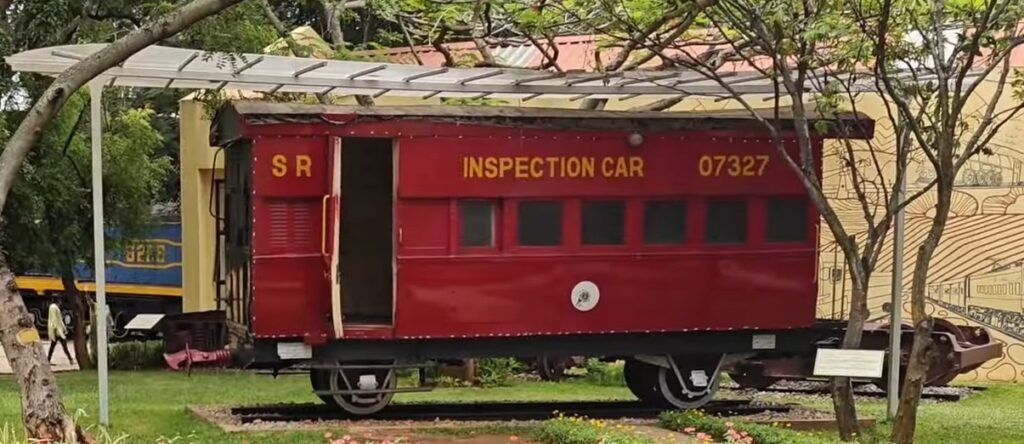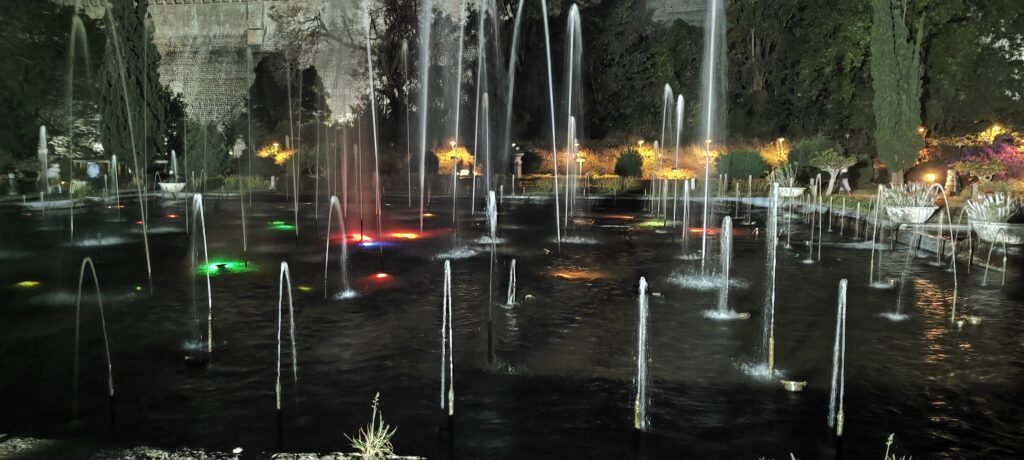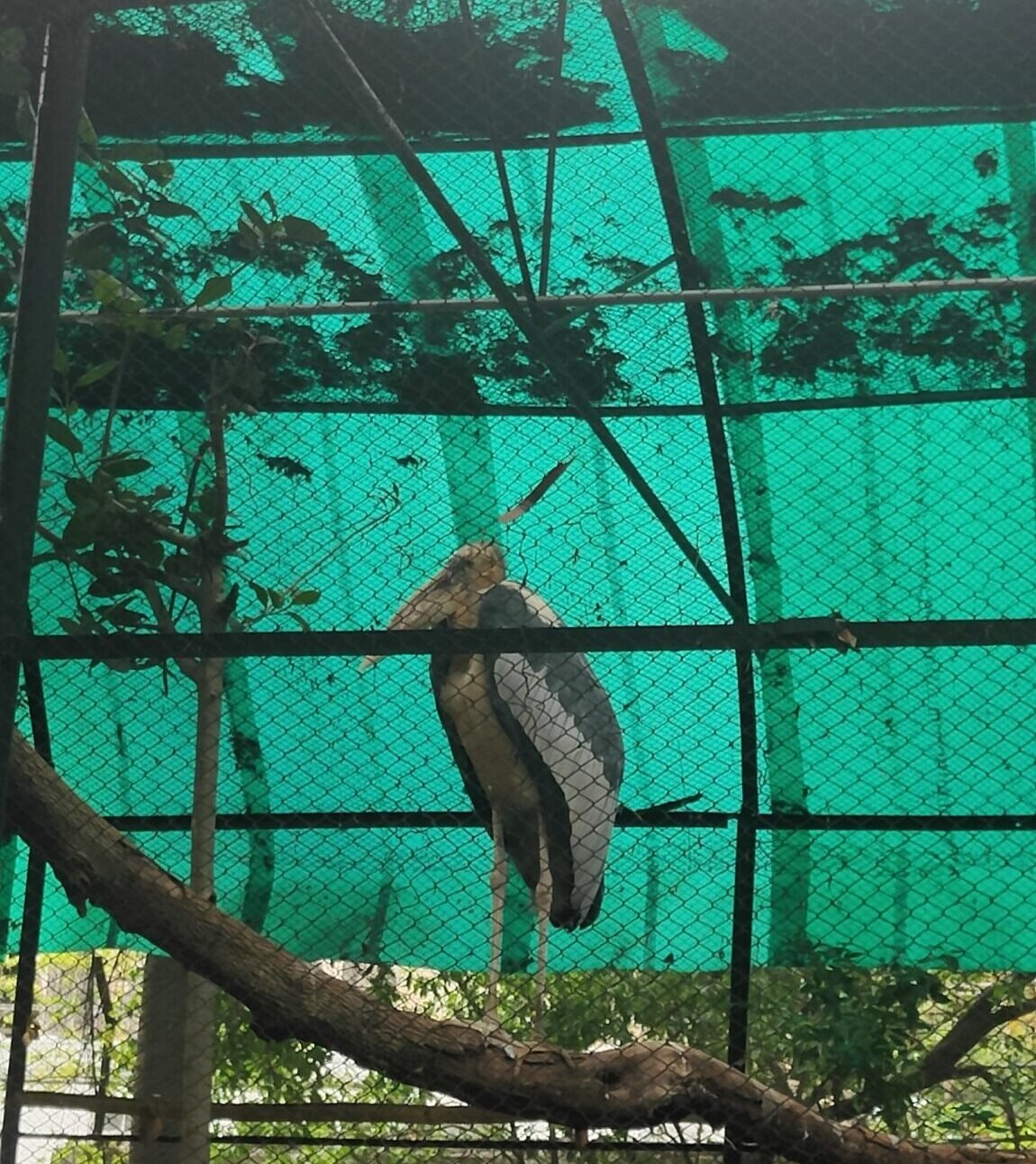Looking for the perfect Mysore itinerary for 2 days? This guide offers top attractions, hidden gems, and tips to help you explore the royal city.
What fascinated me most about the Wadiyar dynasty is how they embraced art, culture, and architecture. The construction of the Mysore Palace, one of the grandest royal residences in India, is a testimony to their contribution to art and architecture. The palace, with its blend of Hindu, Mughal, and European architectural styles, is a masterpiece that reflects the grandeur of its reign.
Table of Contents
History Of “Mysore”
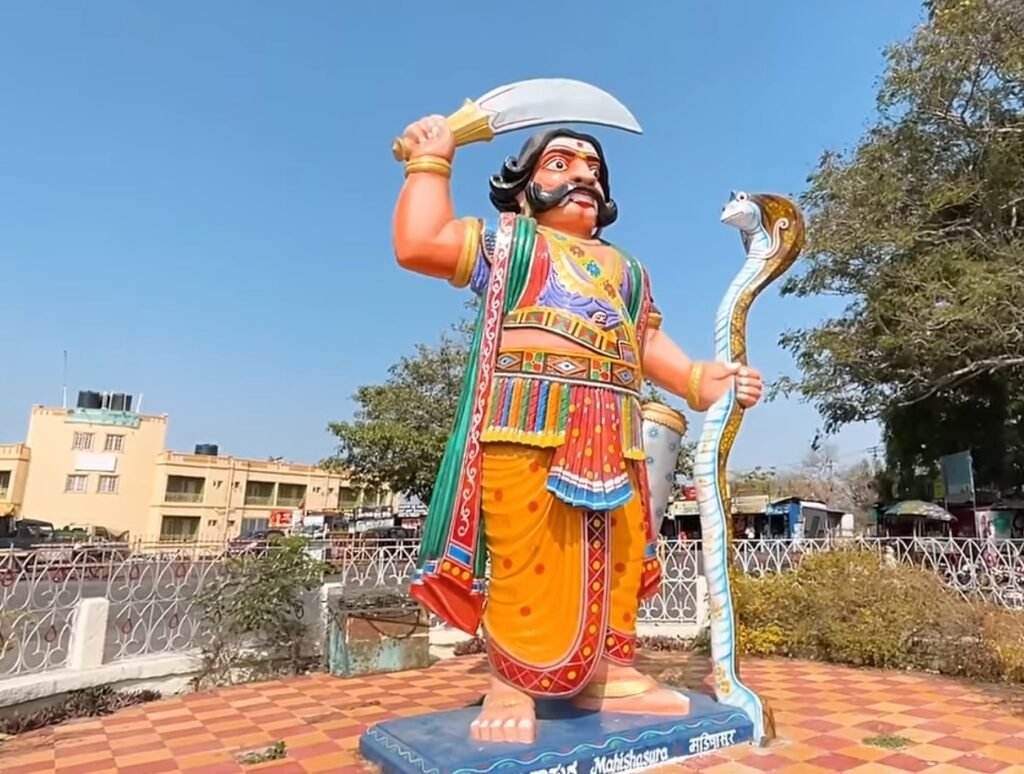
Statue Of Demon Mahishasura At Chamundi Hills.
We see the history of the name Mysore, which is linked to mythology. The name Mysore is believed to be derived from a demon called “Mahishasura” Chamundeshwari Devi defeated this demon in a battle and ended it and the Chamundeshwari Hill still stands near Mysore as a testimony to this event.
History tells us that the Wadiyar dynasty ruled Mysore for more than 500 years. The Wadiyar dynasty ruled the region around Mysore from roughly 1399. At that time, Mysore was under the Vijayanagara Empire. Later in the 16th century, after the fall of the Vijayanagara Empire, the Wadiyar kings here declared their independence from the Vijayanagara Empire and established Mysore as a separate kingdom. Hyder Ali and Tipu Sultan both contributed to the Mysore state’s important place in history.
The history of Mysore State is not complete without mentioning Tipu Sultan. After becoming the ruler of Mysore, Tipu Sultan made many reforms in his state by implementing various schemes and improving the socio-political and economic conditions of the Mysore state. Tipu Sultan died in the fourth British Mysore War in 1799 and after that, the British handed over the kingdom of Mysore to the old Wadiyar dynasty. Later, Mysore continued to function as a princely state under British rule.
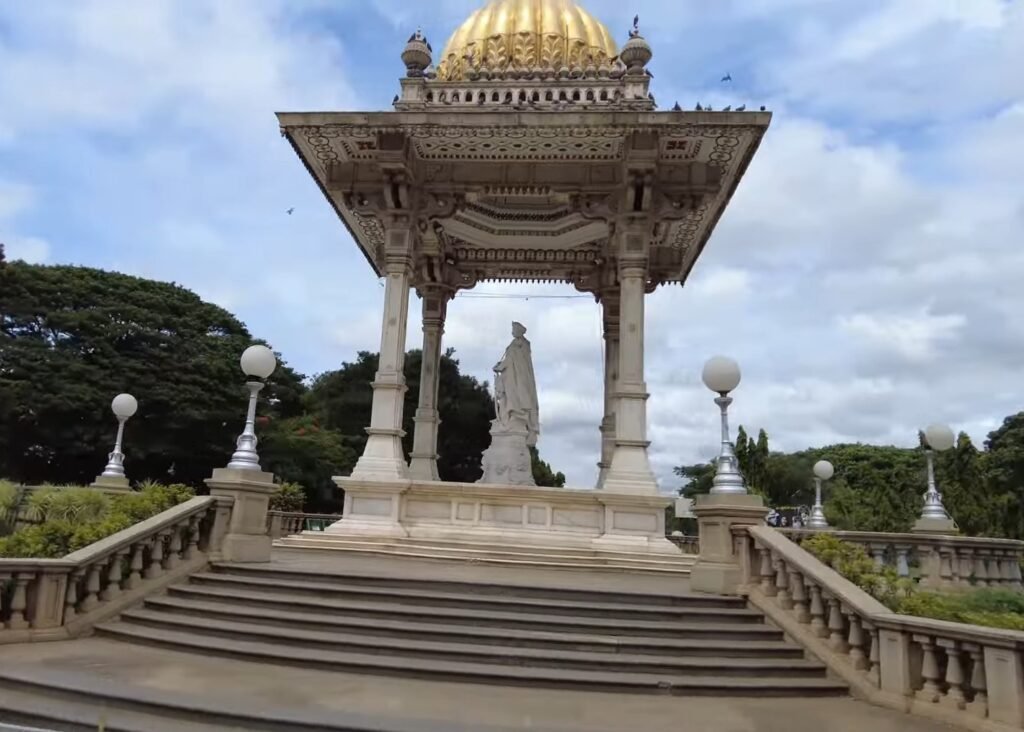
The dynasty continued to rule until India’s independence in 1947, when the last king, Jayachamarajendra Wadiyar, agreed to merge Mysore with the newly formed Indian state of Karnataka.
Walking through Mysore and exploring its royal heritage made me realize how the Wadiyar dynasty not only shaped the history of the city but also left a lasting cultural legacy. The blend of tradition and modernity that the Wadiyars fostered is still reflecting in Mysore today.
Best time to visit Mysore
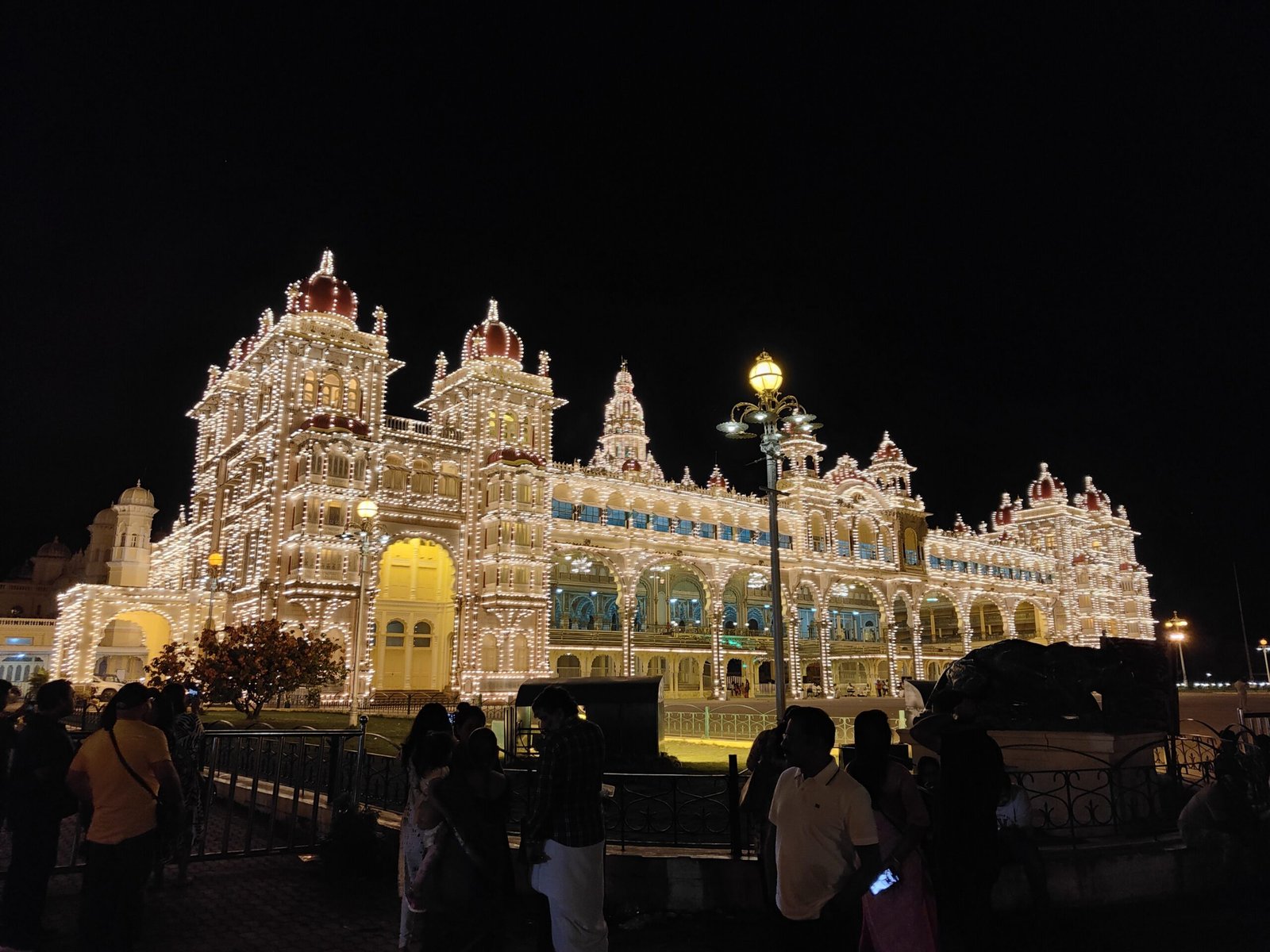
A Beautiful Night View Of Mysore Palace.
Winter Months:
I recently visited Mysore city and from the experience of that visit, I would like to tell you that if you are planning to visit Mysore then October to February will be the best time for you as the temperature in and around Mysore is between 15 to 30 degrees Celsius and I think this temperature is perfect for us to visit different places.
I visited this city in October and the Dussehra festival in this month is one of the main attractions of the city the whole city is lit up with different lighting and the scene is quite mesmerizing. The illumination of the Mysore Palace during the Dussehra festival is absolutely magical.
If you are visiting Mysore city during the Dussehra festival, don’t forget to see this beautiful view of the Mysore Palace at night. If you want to experience the peaceful city of Mysore, then you can plan to visit between November and January.
Monsoon Season:
Mysore receives good rainfall during the monsoon months of July to September and the surrounding nature is filled with greenery so if you want to visit this city during the monsoon then you can plan accordingly.
Summer timings:
From my experience, I would like to say that you should avoid visiting this city during summer as the temperature here reaches 35 to 38 degrees Celsius and the places in the city are far apart so you may feel some difficulty in travelling during summer so if you want to visit Mysore city with family. If you are planning, I would suggest October to February as the best time
How to reach Mysore
If you are visiting Mysore, you can choose any way according to your convenience i.e. by air, by rail, and by road. Mysore city is very well connected to various cities of the country by rail and road.
Travelling by Air:
Although there is a small domestic airport in Mysore city, I would suggest you land at Kempagoda International Airport in Bangalore and from there take a taxi or a Karnataka State Government Bus to Bangalore. The distance from Bangalore to Mysore should be around 170 to 180 Kms. The national highway between Bangalore and Mysore is of very good quality and you will not feel tired at all while travelling on it, the distance can be around three to three and a half hours.
Travelling by Rail:

You can also visit Mysore by rail as it is well connected by rail to almost all major and minor cities in Sun India. Mysore city is connected to Bangalore by Shatabdi Express which you can also experience on this journey.
Travelling by Road:
Mysore is well connected with most of the cities in India through national highways. If your budget is tight, you can opt for buses from cities like Chennai, Bangalore, Mangalore, and Coimbatore which take you to Mysore at a very reasonable price.
My personal opinion:
If you are visiting Mysore city with your family then I would suggest you go by road with your car because different places in Mysore city are quite far from each other so if you have your car then you don’t have to depend on the public transport system to move around here so that your journey will be less stressful.
Where to stay in Mysore.
During my visit to Mysore, I discovered a range of accommodation options that catered to different budgets and preferences. Here’s a guide on where to stay in Mysore, based on my experiences.
Luxury Hotels:
If you are looking for a luxurious stay, I highly recommend the Radisson Blu Plaza Hotel. This hotel offers beautiful rooms with modern amenities and stunning views of the surrounding landscape. The staff was very friendly, and I enjoyed a refreshing swim in their pool after a day of sightseeing. The hotel is also located near major attractions like the Mysore Palace and Chamundi Hills.
Another good option is the Royal Orchid Metropole Hotel. This heritage hotel has a rich history and beautiful architecture. My room was spacious, and I loved relaxing in the lush gardens. The on-site dining options were excellent, especially the local cuisine. It’s a perfect blend of comfort and history.
Mid-Range Hotels:
For a more budget-friendly yet comfortable option, Laika Heritage Stay is an excellent choice. This hotel is famous for its traditional decor and rooms with modern facilities. The location is ideal, as it’s close to the city centre. I enjoyed a delicious breakfast on their terrace, which added to the lovely experience.
Another mid-range option is the Green Hills Hotel. This hotel is known for its hospitality and has spacious rooms equipped with all the necessary amenities. The staff helped provide recommendations for local attractions and dining options. It is also located near the Mysore Zoo, making it convenient for visitors.
Homestays:
If you prefer a more traditional experience, consider staying at a homestay. Sukoon Homestay offers a warm and inviting atmosphere. The owners treated me like family and provided homemade meals that showcased authentic Mysore flavours. The homestay is located in a quiet area, allowing for a peaceful stay while still being close to popular attractions.
Another lovely homestay is Shree Vihar Homestay, situated in a scenic neighbourhood. The rooms are comfortable, and the hosts are incredibly welcoming. I enjoyed chatting with them about Mysore’s culture and history, which added depth to my visit.
Budget Options:
If you’re travelling on a tighter budget, you can find several good options, like Hotel Mysore Palace. It offers basic amenities and is located close to the city centre, making it easy to explore. The staff is friendly, and the rooms are clean. Hotel Dawn is another budget-friendly option that provides better amenities and hospitality as compared to its pricing.
Jungle Lodges and Resorts is another budget-friendly option, especially for nature lovers. This eco-friendly resort offers basic accommodations in a serene environment surrounded by nature. It is slightly away from the city but perfect for those looking to stay with nature.
10 Best Places to See in Mysore
Mysore, known as the “Cultural Capital of Karnataka,” is a city rich in history, art, and architecture. On my recent trip to this magnificent city, I had the chance to explore some of the most beautiful and historically significant places Mysore has to offer. Each location has a unique story and charm that captivated me as a traveller. Here are the 10 best places to see in Mysore, complete with their detailed history, timings, and entry fees.
1. Mysore Palace (Amba Vilas Palace).
Location: Google Maps
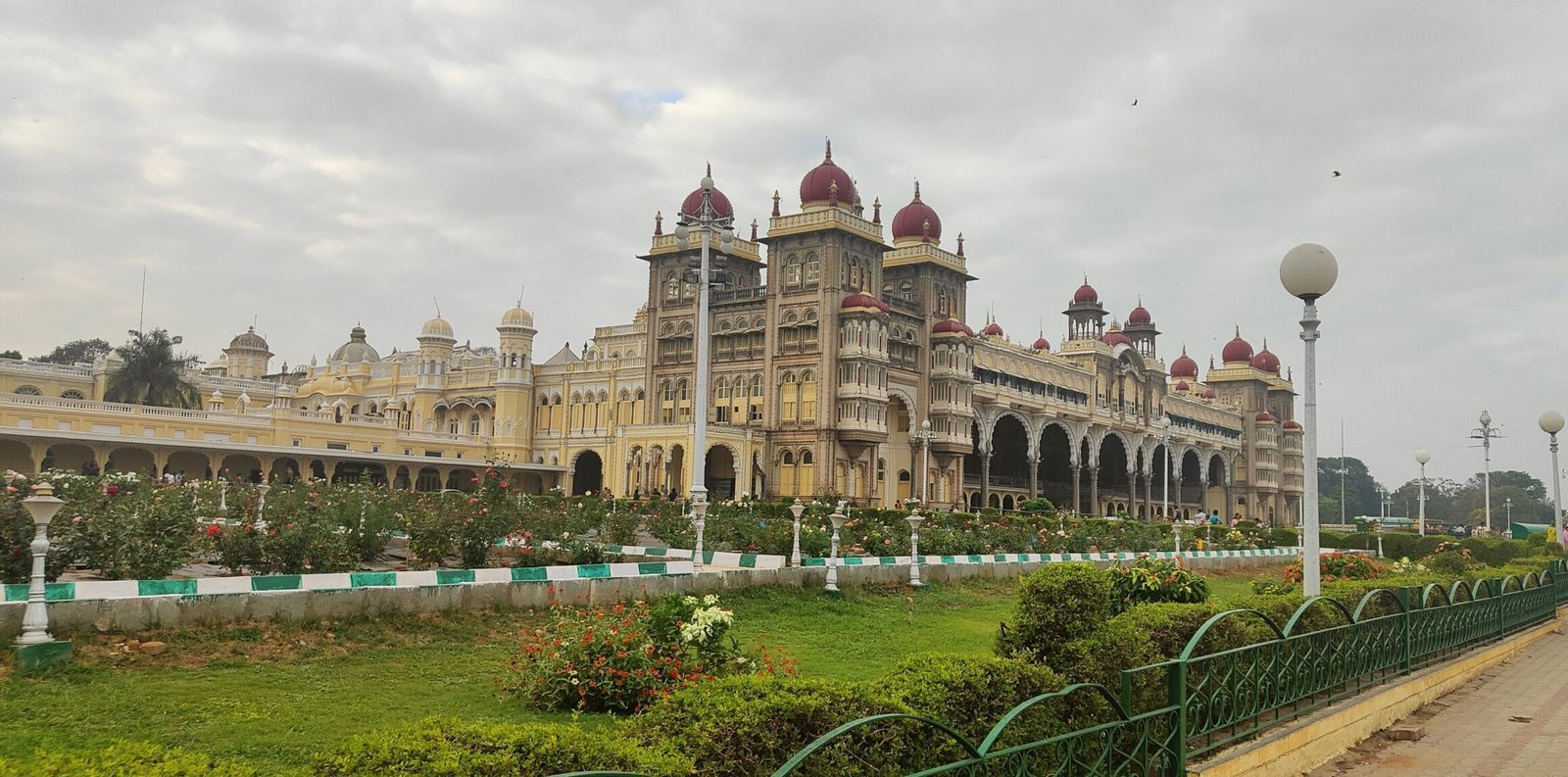
A View Of Mysore Palace.
History:
Mysore Palace is the most iconic landmark in the city. The original palace was built in the 14th century, but the current structure was commissioned by Maharaja Krishnaraja Wodeyar IV in 1897 after the old palace was destroyed by a fire. This palace is designed by a British architect Henry Irwin, the palace is a blend of Hindu, Muslim, Rajput, and Gothic styles, reflecting the diversity of Indian architecture. It was completed in 1912 and is still the royal residence of the Wadiyar family.
The moment I stepped inside the palace, I was transported back in time. The size of the palace, with its intricate carvings, stained glass, and ornate ceilings, was breathtaking. The Durbar Hall, decorated with golden pillars and chandeliers, was especially impressive. I visited during the day, but I made sure to return at night also when the palace is illuminated by 100,000 light bulbs.
Timings: 10:00 AM to 5:30 PM
Entry Fees: ₹100 for adults, ₹50 for children
2. Chamundi Hill and Chamundeshwari Temple
Location: Google Maps

Gopuram Of Chamudi Temple.
History:
Chamundi Hill, located about 13 kilometres from Mysore, is named after Goddess Chamundeshwari, who is considered the guardian deity of Mysore. The Chamundeshwari Temple is located on chamundi hill i.e., one of the oldest temples in the region, dating back to the 12th century. It is believed that Goddess Chamundeshwari, an incarnation of Durga, killed the demon Mahishasura here, representing the victory of good over evil. The temple’s gopuram (tower) is an excellent example of Dravidian architecture.

Climbing the 1,000 steps to the top of Chamundi Hill was both a spiritual and physical journey. The panoramic view of Mysore city from the top was very beautiful. The temple itself was serene, and the idol of Chamundeshwari was beautifully decorated. There’s also a giant statue of the demon Mahishasura at the entrance, which serves as a reminder of the region’s mythological history.
Timings: 7:30 AM to 2:00 PM, 3:30 PM to 6:00 PM, 7:30 PM to 9:00 PM
Entry Fees: Free
3. Brindavan Gardens
Location: Google Maps
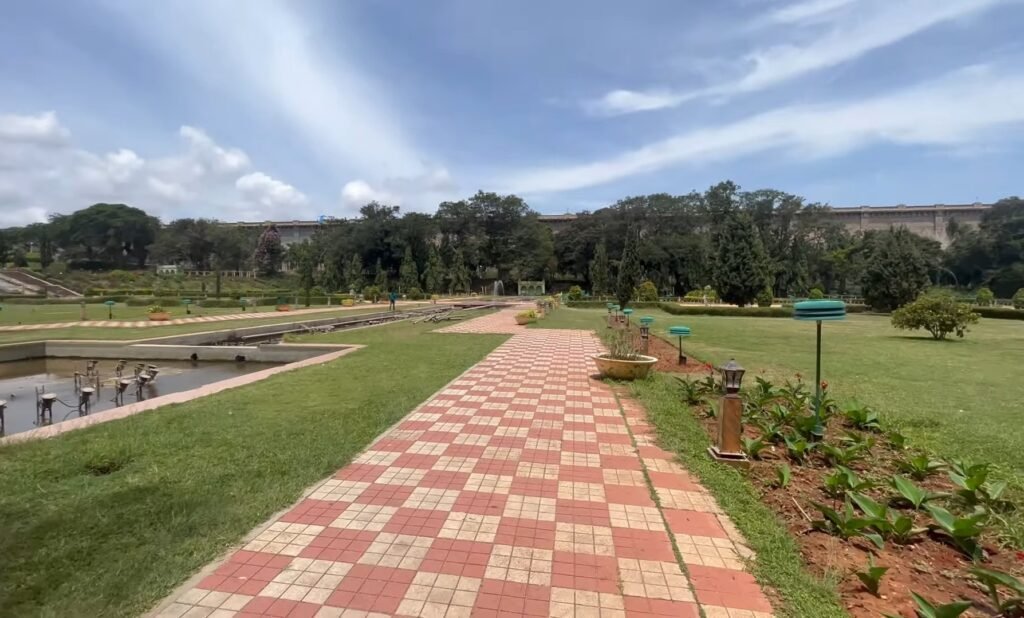
A View Of Brindavan Gardens
History:
The Brindavan Gardens, situated 23 kilometres from Mysore, are famous for their symmetrical design and musical fountains. Built-in the 1930s, these gardens were designed to beautify the area around the Krishnaraja Sagara Dam, which was constructed across the Cauvery River. Sir Mirza Ismail, the then Dewan of Mysore, played an important role in developing these gardens, which are inspired by the Shalimar Gardens of Kashmir.
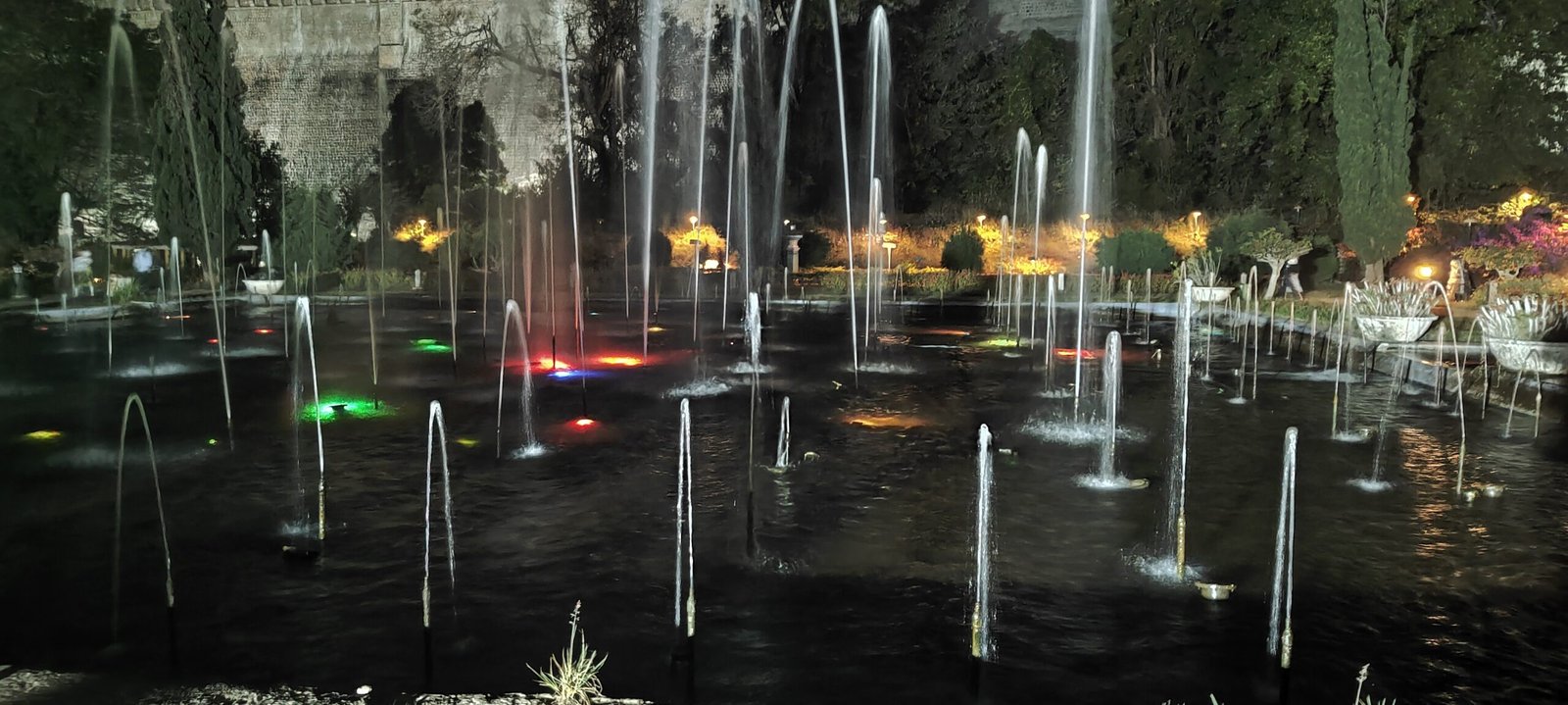
A Fountain Show At Brindavan Gardens.
I visited the gardens in the evening, and the cool breeze from the Cauvery River made it a pleasant experience. The highlight of my visit was the musical fountain show, where water jets danced in according to the rhythm of traditional Indian music. The gardens, illuminated with colourful lights, provided the perfect atmosphere to spend a relaxing evening here.
Timings: 6:30 AM to 9:00 PM
Entry Fees: ₹30 for adults, ₹10 for children, ₹70 for the musical fountain
4. Mysore Zoo (Sri Chamarajendra Zoological Gardens)
Location: Google Maps

History:
Mysore Zoo is one of the oldest and most well-maintained zoos in India. It was developed by Maharaja Jayamaraja Wadiyar in 1892 and was later opened to the public. The zoo is spread over 157 acres and has a wide variety of animals, including some rare and endangered species.
I spent 2-3 hours while exploring Mysore Zoo, and it was worth it. The zoo is beautifully laid out, and the enclosures are spacious, giving the animals plenty of room to roam. I saw tigers, elephants, giraffes, and even a pair of African lions. The zoo also has a section dedicated to reptiles and birds. It’s a great place to visit, especially if you’re travelling with kids.
Timings: 8:30 AM to 5:30 PM (Closed on Tuesdays)
Entry Fees: ₹80 for adults, ₹40 for children
5. St. Philomena’s Church.
Location: Google Maps
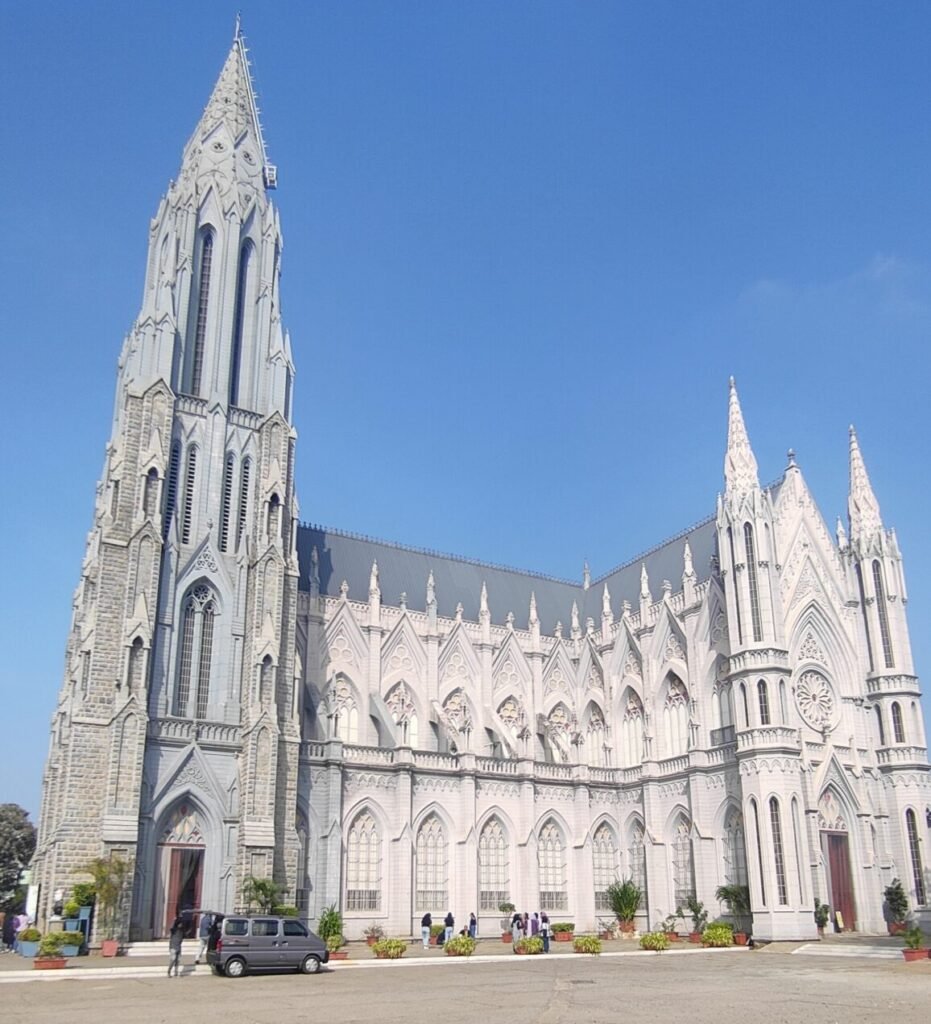
A Mesmerizing View Of St Philomena Cathedral Church Mysore.
History:
St. Philomena’s Church is one of the largest churches in India and a significant landmark in Mysore. The church was built in 1936 in the neo-Gothic style, inspired by the Cologne Cathedral in Germany. It is dedicated to St. Philomena, a 3rd-century Greek saint who was martyred for her faith.
The towering spires of the church are visible from a distance, and as I walked closer, The glass windows inside the church depict scenes from the life of Christ, and the overall atmosphere is one of peace and reverence. The church is a must-visit for anyone interested in history and architecture.
Timings: 5:00 AM to 6:00 PM
Entry Fees: Free
6. Jaganmohan Palace.
Location: Google Maps

History:
Jaganmohan Palace was built in 1861 as a residence for the royal family after the old Mysore Palace was destroyed by a fire. It was later converted into an art gallery and museum. The palace consists of a collection of paintings, including works by the famous Indian artist Raja Ravi Varma.
The art lover in me was thrilled to explore the Jaganmohan Palace. The gallery’s collection of paintings is remarkable, with small details and accurate colours that reflect the rich culture of Mysore. The palace also has a collection of antique weapons, sculptures, and musical instruments. It’s a hidden gem for anyone interested in art and history.
Timings: 10:00 AM to 5:30 PM
Entry Fees: ₹50 for adults, ₹20 for children
7. Lalitha Mahal Palace.
Location: Google Maps

The Lalitha Palace.
History:
Lalitha Mahal Palace, built in 1921, was initially used as a guest house for the Viceroy of India. Designed by E.W. Fritchley, the palace is a beautiful example of European architecture, with its white facade and dome resembling St. Paul’s Cathedral in London. Today, it has been converted into a luxury hotel managed by the Karnataka State Tourism Development Corporation. It also features in many Bollywood and South Indian films. It features most famously in the KGF and KGF 2 movies.

A Walkway Inside The Lalitha Palace.
Even though I wasn’t staying at the palace, I took a guided tour. The interiors, with its marble staircases, Belgian crystal chandeliers, and ornate furniture, were amazing. The hotel also has a lovely tea room where I enjoyed a cup of coffee while taking in the beautiful views of Chamundi Hill.
Timings: 10:00 AM to 6:00 PM (for tours)
Entry Fees: ₹100 for guided tours
8. Karanji Lake.
Location: Google Maps

History:
Karanji Lake, located at the foot of Chamundi Hill, is a man-made lake developed by the Mysore Zoo authorities. The lake covers an area of 90 acres and is an excellent spot for bird watching, as it is home to several species of migratory birds.
I visited Karanji Lake for some relaxation after a busy day of sightseeing, it did not disappoint me. The peaceful environment, coupled with the chirping of birds, made for a perfect experience. There’s a small island in the middle of the lake where you can take a boat ride. The lake also has a butterfly park, which was a delightful addition to my visit.
Timings: 8:30 AM to 5:30 PM (Closed on Tuesdays)
Entry Fees: ₹30 for adults, ₹20 for children, ₹50 for boat rides
9. Devaraja Market.
Location: Google Maps
History:
Devaraja Market, located in the heart of Mysore, is one of the oldest markets in the city, dating back to the reign of Tipu Sultan. The market offers everything from fresh produce to traditional Mysore silk.
Walking through Devaraja Market was an immersive experience. I had the chance to interact with local vendors who share stories about their products. The market is a great place to pick up souvenirs like sandalwood products, silk sarees, and Mysore Pak (a famous sweet).
Timings: 6:00 AM to 9:00 PM
Entry Fees: Free
10. Railway Museum.
Location: Google Maps

History:
The Railway Museum in Mysore was established in 1979 and is dedicated to showcasing the rich history of Indian Railways. It houses vintage locomotives, and carriages that date back to the British era, providing insight into the evolution of rail transport in India.
Visiting the Railway Museum was a delightful journey through time. As I wandered through the museum, I was amazed by the collection of vintage trains and the beautifully preserved artefacts that told the story of the Indian Railways. I particularly enjoyed exploring the steam locomotives, which were impressive with their size and power. The museum also features a miniature train ride, which was a fun experience that took me around the grounds. The knowledgeable staff shared interesting facts about the trains and their history, making my visit all the more memorable.
Timings: 10:00 AM to 5:30 PM (Closed on Tuesdays)
Entry Fees: ₹50 for adults, ₹20 for children.
What to eat at Mysore
When I first arrived in Mysore, I was eager to explore the city’s rich test heritage. Mysore is not only known for its palaces and gardens but also for its unique and flavorful cuisine that reflects the culture of Karnataka. During my trip, I made it a point to taste some of the most popular local dishes, and I must say, the experience was more than my expectations
1. Mysore Masala Dosa:

The first dish I tried was the famous Mysore Masala Dosa. I had heard so much about this crispy, golden dosa filled with spicy potato masala with a special chutney made from red chillies and garlic. It was served with coconut chutney and sambar, and the combination of flavours was incredible. The slight spiciness of the dosa, combined with the cooling coconut chutney, made for a perfect breakfast.
2. Bisi Bele Bath:
For lunch, I tried a traditional Mysore dish called Bisi Bele Bath. This is a one-pot meal made with rice, lentils, vegetables, and a special blend of spices. The dish was warm, comforting, and had a rich, tangy flavour. It’s usually served with a dollop of ghee on top and some crispy papad (thin crackers) on the side. It was a satisfying meal, and I understood why it’s such a popular dish among locals.
3. Mysore Pak:

No trip to Mysore is complete without tasting Mysore Pak, the city’s most famous sweet. I visited a small, traditional sweet shop to get some fresh Mysore Pak, and I was blown away by its texture and flavour. Made from ghee, sugar, and gram flour, this sweet treat literally melts in your mouth. The richness of the ghee and the slight crunch from the flour make it a must-try for anyone visiting Mysore. I couldn’t resist buying a box to take back home!
4. Ragi Mudde:
Another unique dish I tried during my stay in Mysore was Ragi Mudde, which is a staple food in Karnataka. This dish is made from finger millet flour and is usually eaten with a spicy curry or sambar. Though simple in appearance, Ragi Mudde is very nutritious. It has a slightly earthy flavour, and when combined with a flavorful curry, it becomes a perfect meal. It’s a dish that locals eat regularly, and I appreciate its health benefits.
5. Chiroti:
If you are a sweet dish lover like me, you’ll love Chiroti, another traditional Mysore dessert. Chiroti is a layered, flaky pastry made from refined flour and ghee, and it’s usually served with a sprinkling of powdered sugar and warm milk. The pastry was light, crisp, and perfectly sweetened, making it a perfect end to a meal.
6. Filter Coffee:
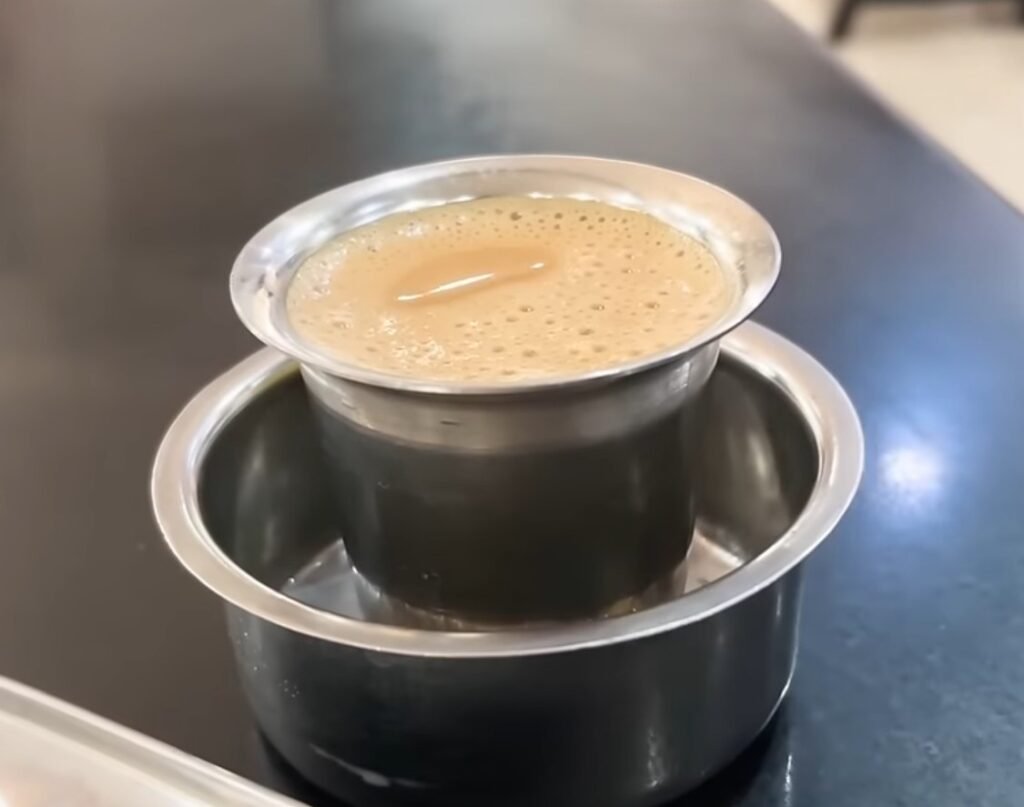
Of course, no meal in Mysore is complete without a cup of filter coffee. Mysore’s coffee culture is something I thoroughly enjoyed. Made from freshly ground coffee beans, boiled milk, and sugar, Mysore filter coffee has a rich and aromatic flavour.
What to shop at Mysore
Mysore offers a unique blend of traditional and modern items, making it a shopper’s paradise. Whether you’re looking for luxurious silk sarees, fragrant sandalwood products, or designed handicrafts, Mysore has something for everyone. Here are some of the best things to shop for in Mysore based on my experience.
1. Mysore Silk Sarees:

One of the most iconic and luxurious items you can buy in Mysore is the Mysore silk saree. Known for their rich texture and intricate gold zari work, I visited a silk weaving unit and was amazed to see how much effort and craftsmanship go into making these sarees. The silk here is known for its superior quality, and the traditional designs reflect the city’s royal heritage. Stores like KSIC (Karnataka Silk Industries Corporation) are well-known for offering authentic Mysore silk sarees. It is on the expensive side, but the sarees are worth it, making them a valuable gift for someone special.
2. Sandalwood Products:
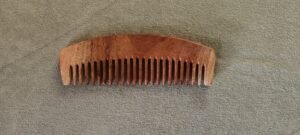
Mysore is famous for its sandalwood. From fragrant sandalwood oil to intricately carved sandalwood artefacts, the variety is overwhelming. I visited Cauvery Handicrafts Emporium, a government-run store, where I found a vast collection of high-quality sandalwood products. I purchased a small sandalwood idol and a bottle of sandalwood oil, both of which are known for their therapeutic properties. The sweet aroma of sandalwood is believed to bring peace and relaxation, and I found that the oil worked wonders for calming my senses after a long day of exploring the city.
3. Incense Sticks (Agarbattis):
Mysore is also famous for its incense sticks, particularly those made with sandalwood. These aromatic agarbatti are famous around the world. The best part is that you can find them in a variety of fragrances such as rose, jasmine, and lavender. Nandi Agarbatti is one of the well-known brands in Mysore. I bought several boxes of these incense sticks as they make perfect gifts for friends and family back home. Their fragrance brings a piece of Mysore City into my home even after the trip.
4. Mysore Paintings:
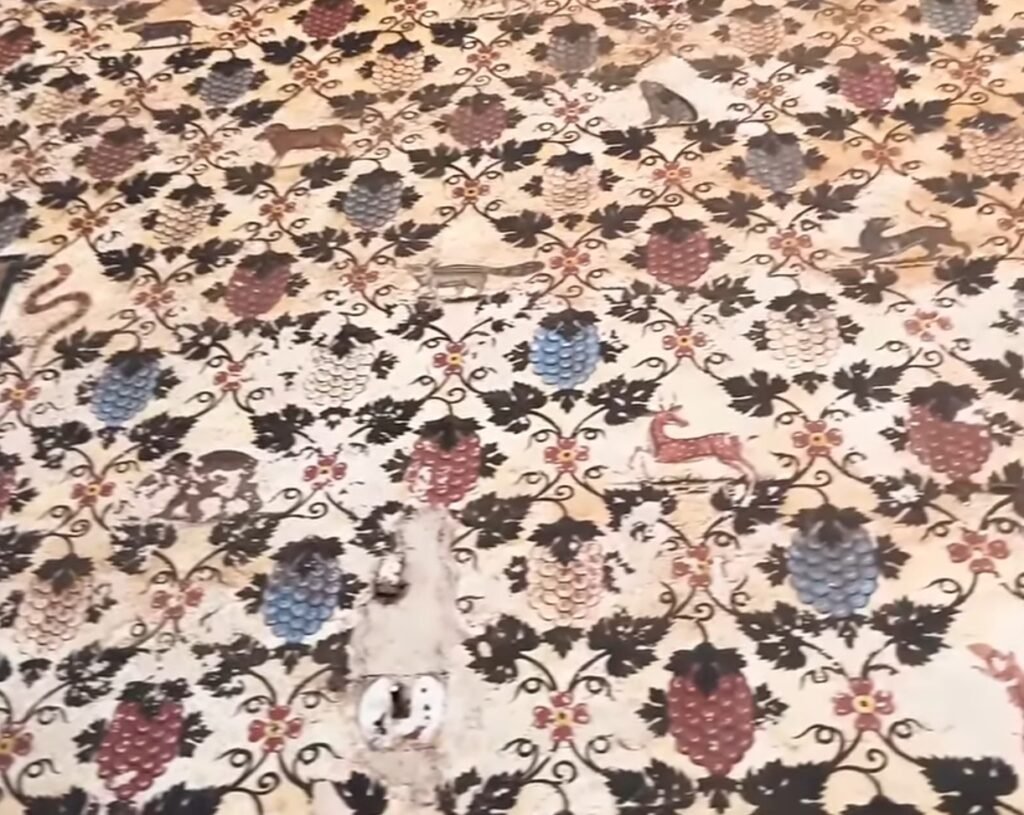
If you’re an art enthusiast, Mysore paintings are something you shouldn’t miss. These paintings are known for their detailing and vibrant colours, often depicting mythological themes and religious figures. I picked up a small painting of Lord Krishna at a local art store, and it now serves as a beautiful memory of my trip. If you’re looking for authentic Mysore paintings, be sure to visit the Chamarajendra Academy of Visual Arts or some government-run emporiums.
5. Stone Sculptures:
Another unique item in Mysore is stone sculptures. The city is famous for its artisans who craft beautiful sculptures out of soapstone and other materials. From small deities to larger, more elaborate pieces, these sculptures reflect the rich cultural heritage of Mysore. I bought a small soapstone elephant, a traditional symbol of strength and wisdom, from a local artisan near Devaraja Market. The attention to detail in these pieces is simply outstanding, and they make for wonderful home décor items or gifts.
6. Sweets: Mysore Pak

As someone who is a sweet lover, this was one of the first things to capture. Mysore Pak is a rich, buttery sweet made with ghee, sugar, and gram flour. The best place to try and buy this delicacy is at Guru Sweets, which is famous for its authentic Mysore Pak. If you’re visiting Mysore, don’t leave without a taste of this iconic sweet.
7. Rosewood inlay work:

Mysore is also known for its rosewood inlay work, where delicate designs are carved into rosewood and inlaid with ivory or other materials. I visited a workshop where skilled artisans were busy creating detailed designs on rosewood. The craftsmanship was truly impressive. I bought a small rosewood box with inlay work, Whether it’s furniture, boxes, or other decorative items, rosewood inlay work is a fantastic souvenir to bring home.
Best shopping places in Mysore
During my visit to Mysore, From colourful markets to government-run emporiums, Mysore offers a diverse shopping experience that combines tradition with local craftsmanship. As a traveller who enjoys picking up souvenirs, I found Mysore to be a shopper’s paradise.
1. Devaraja Market:
The Devaraja Market was one of the first places I visited. Located in the heart of the city, full of vibrant colors, fragrances, and local vendors selling everything from fruits and vegetables to flowers, spices, and traditional goods. One of the highlights here was purchasing freshly ground coffee and aromatic spices like cardamom and cinnamon. The market also offers beautiful incense sticks (agarbattis), many of which are made locally. It’s a great place to pick up affordable items.
2. Cauvery Handicrafts Emporium:
For anyone looking for authentic, high-quality products, the Cauvery Handicrafts Emporium is a must-visit. This government-run store is known for selling a wide variety of sandalwood products, Mysore silk sarees, and rosewood inlay work. I bought a small sandalwood statue and a bottle of sandalwood oil, which are perfect reminders of Mysore’s famous craftsmanship. The emporium offers fixed prices, ensuring the authenticity and quality of each item, making it a hassle-free shopping experience.
3. Ashoka Road:
If you’re interested in Mysore silk, Ashoka Road is the place to be. This area is filled with shops selling a variety of silk sarees. KSIC (Karnataka Silk Industries Corporation) is one of the most reputable places to buy genuine Mysore silk sarees. Known for their rich texture and vibrant colors, these sarees are woven with gold zari, making them perfect for special occasions.
4. Channapatna Toys:
Just outside Mysore, the town of Channapatna is famous for its colorful wooden toys. I made a short trip there to explore the local craftsmanship. The toys are handcrafted using traditional techniques and eco-friendly, non-toxic dyes. These toys make for excellent gifts, especially for children. I ended up buying a few wooden dolls, which were simple yet beautifully made, reminding me of the rich tradition of craftsmanship in the region.
5. Mysore Palace Road:
If you’re in the mood for street shopping, a short walk along Mysore Palace Road is an exciting experience. Small shops line the road, offering a wide range of products, from brass items to handicrafts, and even traditional jewelry. I found the prices to be reasonable, and with a bit of bargaining, you can find some great deals. The handmade trinkets and jewelry here make for unique keepsakes, reflecting Mysore’s royal heritage.
Mysore itinerary for 2 days
Day 1: Exploring the Heart of Mysore
Morning: Mysore Palace
I started my Mysore trip by visiting the iconic Mysore Palace, one of the most grand and historically significant landmarks in India. The architecture is breathtaking, with its blend of Indo-Saracenic styles.
I spent a few hours exploring the palace’s grand halls, ornate interiors, and beautiful courtyards. The audio guide offered fascinating stories about the Wodeyar dynasty, which ruled Mysore for centuries. Don’t forget to capture some photos of the palace’s intricate domes and arches!
Timing: 10:00 AM to 5:30 PM
Entry Fee: ₹100 for adults, ₹50 for children
Afternoon: St. Philomena’s Cathedral

St. Philomena’s Cathedral.
After soaking in the royal grandeur, I visited St. Philomena’s Cathedral, one of the tallest churches in India. Its Gothic architecture reminded me of Europe, and the stained glass windows were absolutely beautiful. The peaceful ambience inside made it a perfect stop for some quiet reflection after a morning of sightseeing.
Timing: 8:00 AM to 6:00 PM
Entry Fee: Free
Lunch: Local Delicacies
For lunch, I headed to one of Mysore’s many eateries and enjoyed a traditional South Indian thali. I highly recommend trying the Mysore masala dosa – it was crispy, spicy, and simply delicious!
Evening: Brindavan Gardens
In the evening, I made my way to Brindavan Gardens, located just outside the city. The gardens are famous for their illuminated fountains, which light up after sunset. I took a peaceful stroll through the manicured lawns and flowerbeds before settling in to watch the musical fountain show – a magical end to the first day!
Timing: 6:30 AM to 9:00 PM (Musical fountain: 7:00 PM to 8:00 PM)
Entry Fee: ₹30 for adults, ₹15 for children
Day 2: Nature, History, and Shopping
Morning: Chamundi Hill

A View Of Mysore City From Chamundi Hills.
The next morning, I started early with a visit to Chamundi Hill, which offers panoramic views of Mysore. At the top, you’ll find the Chamundeshwari Temple, dedicated to the goddess Chamundeshwari. The temple’s spiritual atmosphere and the scenic beauty around the hill made it a refreshing way to start the day. If you’re feeling adventurous, you can climb the 1,000 steps to the top – a rewarding challenge!
Timing: 7:30 AM to 2:00 PM, 3:30 PM to 6:00 PM
Entry Fee: Free
Mid-Morning: Mysore Zoo
From Chamundi Hill, I made my way to Mysore Zoo, one of the oldest and most well-maintained zoos in India. The zoo houses a wide variety of animals, from elephants to tigers, and even exotic species like giraffes and zebras. It’s a great stop for families and wildlife enthusiasts alike.
Timing: 8:30 AM to 5:30 PM
Entry Fee: ₹70 for adults, ₹40 for children
Afternoon: Lunch & Devaraja Market
After the zoo, I had a quick lunch and then explored Devaraja Market. This bustling local market is a vibrant place full of fresh produce, spices, flowers, and traditional Mysore silk. I picked up some sandalwood products and colourful silk sarees as souvenirs. It’s a fantastic place to experience local culture and practice some bargaining!
Timing: Open all-day
Entry Fee: Free
Evening: Karanji Lake
I wrapped up my Mysore trip with a relaxing evening at Karanji Lake, where I enjoyed a serene boat ride amidst the tranquil surroundings. The lake is surrounded by a nature park, making it an ideal spot for birdwatching and unwinding before heading back.
Timing: 8:30 AM to 5:30 PM
Entry Fee: ₹30 for adults, ₹15 for children
Conclusion

Mysore is a city that beautifully mixes history, culture, and natural beauty. Each place I visited offered a unique insight into the city’s rich heritage. Whether you are wandering through the majestic Mysore Palace, exploring markets, or enjoying the tranquillity of Karanji Lake, there is something for every traveller. Mysore is not just a destination; it’s an experience that stays with you long after you leave it. And this Mysore Itinerary for 2 days going to help you a lot. Good Bye And Happy Journey To All Of You…
Map Of Mysore City.
FAQs On Mysore Itinerary for 2 Days:
1. What is the best time to visit Mysore?
The best time to visit Mysore is from October to March when the weather is pleasant and perfect for sightseeing. I visited in October during the famous Mysore Dussehra, and it was an incredible experience, with vibrant celebrations throughout the city.
2. How can I reach Mysore?
Mysore is well-connected by road, rail, and air. I flew into Bangalore’s Kempegowda International Airport and took a three-hour drive to Mysore. You can also take a train, like the Shatabdi Express, which offers a comfortable journey from Bangalore.
3. What are the must-visit attractions in Mysore?
Some of the top attractions are the Mysore Palace, Chamundi Hill, Brindavan Gardens, and the Mysore Zoo. I personally loved the palace, with its intricate design, and the view from Chamundi Hill was breathtaking.
4. How many days are enough to explore Mysore?
Two to three days are ideal for exploring Mysore. I spent two days there and was able to comfortably visit most of the major attractions.
5. What is Mysore famous for?
Mysore is renowned for its silk sarees, sandalwood products, and the Mysore Palace. I made sure to buy a Mysore silk saree as a souvenir!
6. Is Mysore safe for tourists?
Yes, Mysore is generally safe for tourists. I found the city to be very welcoming, with friendly locals and good public transportation.
7. What can I shop for in Mysore?
Mysore is known for Mysore silk, sandalwood items, and handicrafts. I picked up some sandalwood oil and a few handicrafts from the local markets during my visit.



